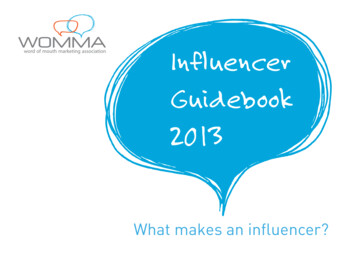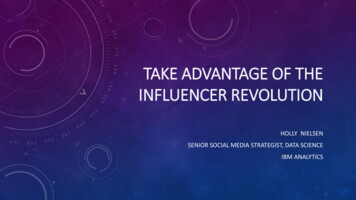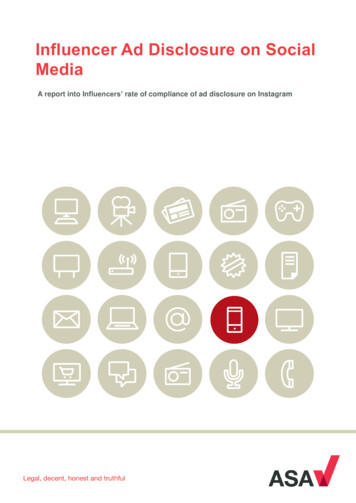
Transcription
Brand InfluencersWOMMA 2013InfluencerGuidebook2013What makes an influencer?
Brand InfluencersIntroductionWOMMA 2013The WOMMA Influencer Guidebook is apractitioner’s resource intended to addressthe needs of the association membership.This is not an update to the 2008 WOMMAInfluencer Handbook - this is a completerewrite taking into context not only howmuch the digital and social landscape haschanged, but also the nuance andsophistication of the now ubiquitouspractice of influencer marketing.Five significant advancements have been captured in this document: The description of the attributes that make up an influencer The classification of five categories of influencers The inclusion of ‘key influencer’ and ‘influencee’ in the definitionsof influencer marketing The differentiation between ‘potential to influence’ and thepractice of empirically measuring ‘actual influence’ A discussion of three levels of considerations when constructingan influencer marketing program
Brand InfluencersWOMMA 2013Intended use of this guidebook:This guidebook is intended to be an educational resource for marketers tobetter understand the mechanics and metrics of influencer marketing. Thisguidebook is not intended to offer industry standards or serve as a definitivestatement on the ‘one right way’ to measure and conduct influencer marketingprograms. Standards develop in industries over many years of productivedebate, refinement and case studies. Additionally, academic research exists andcontinues to develop that further clarifies the importance of influencers, theireffectiveness in achieving outcomes and the attributes and characteristics ofindividuals or groups suited to achieving those outcomes, as well as how onewould best measure the potential to influence and the actions taken byinfluencees.Getting started in influencer marketing:A practitioner should consider performing the following steps beforeembarking on an influencer program: Identify time-bound objectives and goals for the program Assess the appropriate industry level factors Develop a benchmark understanding of the brand’s existing potentialinfluencers and those of the competition Create success criteria and determine those capabilities necessary tomeasure success empirically Develop and execute a program to achieve a specific outcome targeted to aspecific category of influencers Measure and report results - adjust accordinglyPage 3 of 42
Brand InfluencersWOMMA 2013This guidebook will aid in the creation and implementation of these influencermarketing program steps.Who is behind this effort?Both individuals and organizations have been instrumental in the creation ofthe Influencer Guidebook 2013. For a complete list of contributors visitwomma.org/influencers. The principal active contributors to this documentwere (in alphabetical order):Neil Beam – Director, MotiveQuest and Chair of the WOMMA Research andMeasurement CouncilBill Chamberlin – Principal Consultant of Social Insights, IBMJane Collins – VP of Market Research, BlogHerSusan Emerick – Manager of Enterprise Social Programs, IBMMichael Fein – Director of Research and Analytics, FanscapeAmy Laine – Principal Market Insights Analyst, IBMAshley Libby – Principal and Founder, The Anca GroupDhara Naik – Account Supervisor and Digital Strategy, Social@OvilvyGR! Brand Experience was responsible for the design and layout of thisguidebook and images were kindly contributed by Big Stock Photo.Our friends and collaborators at #SMMStandards (The Conclave) helpeddevelop the influencer definitions.The tireless and diligent WOMMA staff.Page 4 of 42
Brand InfluencersInfluencerDefinitionsWOMMA 2013Marketers and business communicatorshave been targeting so-called ‘influencers’or ‘influentials’ for decades. It is a strategyborn of experience and intuition - a sensethat people are influenced by other peopleand that some wield greater influence thanothers. But there is wide variation in whatpeople mean by ‘influencers’ or ‘influencermarketing’. The situation begs for acommon language and conceptualframework to aid practitioners.WOMMA has developed the following definitions with an eye foracademic rigor and practitioner utility. With this in mind, considerthat there are more than seven billion people on the earth. Whileanyone can exert influence on others it is rarely practical for brandsto focus on reaching everyone. Hence there is an interest in engagingthose individuals who have disproportionate influence in themarketplace.
Brand InfluencersWOMMA 2013The following definitions were developed by members of WOMMA incollaboration with members of other leading trade groups in the field of publicrelations and marketing.WOMMA defines Influence as:The ability to cause or contribute to achange in opinion or behavior.Where the initial actor is a Key Influencer who is:A person or group of people who possessgreater than average potential to influencedue to attributes such as frequency ofcommunication, personal persuasivenessor size of and centrality to a social network,among others.Page 6 of 42
Brand InfluencersWOMMA 2013Key influencers interact with others, and those they influence are Influencees:A person or group of people who changetheir opinion or behavior as the result ofexposure to new information.Therefore, Influencer Marketing is:The act of a marketer or communicatorengaging with key influencers to act uponinfluencees in pursuit of a businessobjective.Research shows a marketer is most effective when focusing resources on keyinfluencers with the highest propensity to influence a population of influenceesthat are most likely to be influenced. Later, this document explores somedescriptive Attributes of an influencer thereby enabling a program manager toidentify influencers and influencees for effective program design. The attributesthemselves are useful for characterizing five categories of influencers who eachpossess a unique attribute profile.Page 7 of 42
Brand InfluencersAttributesWOMMA 2013The definitions of influence, key influencerand influencee are important anddemonstrate the relationship betweenindividuals. However, a practitioner needstools to differentiate the qualities or‘attributes’ of one influencer or cohort fromanother. Following are some practicalattributes that a program manager can useto benchmark an individual’s or group ofcohort’s potential to influence.
Brand InfluencersAttributeAffiliation with BrandReachWOMMA 2013DescriptionThe extent to which an influencer is affiliated with the brand. Are they seen asindependent and unbiased or possessing bias? Is there a formal relationshipbetween the individual and the brand? Are they compensated?A count of the number of people that the individual is connected to directly orindirectly via social media and off-line channels. This represents the potentialnumber of people who could possibly receive a message from the individual.Network CentralityThe number and strength of connections between people in a social network. This isa statistical term and is readily modeled using software when data is accessible.Intent to InfluenceThe motive of the individual when communicating. While this is difficult to measure,the influencer’s intent can affect their perceived trust and the outcomes achieved.Degree of EnthusiasmOften measured as sentiment. The strength of emotion expressed in a conversationfor a given subject.Venue DurationThe length of time in which the individual is engaged in a venue (Facebook, Twitter,user group, community, etc.).Topic DurationPage 9 of 42The length of time in which the individual posts on a given subject.
Brand InfluencersFrequency of ContentContent QualityContent EngagementWOMMA 2013The number of repetitions of posting content on a given subject in a unit of time.The degree to which the content is well written, well timed, engaging, visuallyappealing and audience specific.The extent to which other people recirculate or propagate the content: Virality;Number of comments; Retweets; Forwards; or Samplings.Two-Way EngagementThe extent to which the individual engages with others in a two-way dialogue. Thedegree to which the individual pushes content versus interacts.Authority and CredibilityThe extent to which the individual possess expertise, trust and commands respect.Authority and credibility is earned or achieved through education, elections,experience or time. In some cases, it is bestowed by the community.Geographic ReachWhere the individual is effective. Consider global, national and local, as well aslanguage spoken and online versus offline.Improvement of an individual’s or cohort’s attributes may be an influencerprogram in itself. Consider ‘content frequency’ when an employee who is anambassador for a brand who blogs once a quarter. Increasing the frequency ofposting can increase this individual’s propensity to influence. Now consider‘content quality’ and ‘two-way engagement’. By improving the attributes of anindividual or a group of individuals the potential outcome could also improve.Page 10 of 42
Brand InfluencersThree LevelsofConsiderationwhenDevelopingan InfluencerProgramWOMMA 2013Let’s say you are tasked with developing aninfluencer program. Which category ofinfluencer(s) are best suited to your yourbrand objectives? What program goalsshould you set? How do you measuresuccess?There are three logical programconsiderations that affect both theselection of a specific category ofinfluencer on which one should focus andsuccess metrics within that program:1. Industry2. Brand3. Influencer Attributes
Brand InfluencersWOMMA 2013IndustryStart with understanding your industry in context to influence and influencers.Is your company B2B or B2C? Are your goods durable or consumable? Durablegoods such as automobiles, faucets, or airplanes have different channels,buying cycles and service needs. How your consumers interact with theseproducts and services is dependent upon your specific industry factors.Industry-Level Considerations: B2B B2C Durable goods Consumable goods Services Regional factors Regulated and non-regulated Channel and retail considerations Brand history, attributes and unique circumstances Macroeconomic factors Microeconomic factorsBrandWhat is the brand’s objective for the influencer marketing program? Are youattempting to affect customer acquisition? If so, where in the purchase funnelwould influencers be helpful? Perhaps customer retention or brand reputationis the program objective, in which case influencers can amplify good sentimentPage 12 of 42
Brand InfluencersWOMMA 2013towards the brand or dampen conversations that are negative towards thebrand.Brand Level Considerations: Improve retention Improve customer lifetime value Improve or accelerate acquisition Provide better customer service and support faster and to more people Improve brand reputationHere one would also want to consider marketplace conditions relative to yourobjectives. For example, what are the influencer programs at the competitor?Also consider your existing capabilities of your influencer program. An inhibitoror enabler to your goals may be your company’s governance and regulationsaround social media and consumer engagement. The absence of a policy maybe as much an inhibitor or enabler as the existence of a overly burdensomepolicy. Legal departments at some firms will require a policy to be in place beforeproceeding with an influencer program, should one not already exist.Influencer AttributesThe third consideration set is influencer attributes themselves. One could startwith a benchmark of existing influencer attributes for both your company andcompetitors. Have you identified key influencers? Are these influencerssupporting your brand or your competition? What is their reach and degree ofenthusiasm for the brand? Once a benchmark of these attributes is understood,an influencer program could be designed with the aim of improving theattributes of influencers. Should you improve the reach of an existing set ofinfluencers or recruit new influencers who have greater reach? Can a programPage 13 of 42
Brand InfluencersWOMMA 2013improve the frequency of content or should you design a program toencourage existing influencers to start conversations on a venue whereprospects and customers (influencees) are more likely to engage?Influencer Attribute Considerations: Improve the reach and connectivity of the influencer network Clarify affiliation, alignment and knowledge of the brand Improve the ability of individuals to influence: Improve content quality;Biographical information; and Individual’s presence Optimize frequency and timing of content posting per venue Optimize venues: Are your influencers talking where influencees arepresent? Improve topic duration, the length of time someone is engaged and activeon a particular topic Improve the degree of enthusiasm towards the brand and topic Location: Global; National; Local; Language spoken; Online versus Off-lineEach Category of Influencer, which will be introduced in the coming pages,lends itself better to some program considerations than others. The specifics arenoted in the the detailed description of each influencer category. The job of aninfluence marketing practitioner is deciding which influencer program to run.This begins with understanding and documenting the program considerationsunique to your business and then aligning these considerations with those ofthe population you wish to affect. The specific key influencer(s) you select arethe link between the desired business outcome and the influencees.Page 14 of 42
Brand InfluencersWOMMA 2013In this guidebook, we outline a number ofsteps that are involved in program design.In this section we discuss measurementconsiderations.How toMeasureanInfluencerProgramThere are two distinct states of influencermeasurement that are relative to the pointin time an influencer marketing programbegins:1. The potential to influence (before)2. Actual, observed influence (during/after)
Brand InfluencersWOMMA 2013These matter because potential and observed influence are distinct programstates, both in terms of time and available tools utilized for measurement.Additionally, as practitioners of influencer marketing, we must always keep inmind that it is rare to measure actual influence. Instead, we observe proxies ofinfluence in the form of outcomes or actions taken. For example, theredemption of a coupon that was given to a friend is an observed action(redeeming a coupon) of an earlier act where a friend influences a purchase (thegiving of the coupon and any context around that transfer).Measurement of potential to influence requires a methodology for determiningwho is influential in the network. While there are no certainties, your objective isto determine the key influencer or cohorts that will maximize the influencerprogram outcomes for your brand. Contemporary methodologies assess thepeople, the network and the content including: The offline conversation volume and brand awareness Third-party scoring results The individual's or cohort’s sentiment towards a brand or topic Content quality and quantity Network size and centrality The individual’s or cohort’s authority, trust and credibilityPage 16 of 42
Brand InfluencersWOMMA 2013Consider the following example. Let's say that you have decided to launch acelebrity influencer program. You made this choice because you determined acelebrity influencer best addresses your business objectives and aligns to bothyour industry and brand level considerations - and you have budget.Having decided to use a celebrity influencer, you must then determine whichcelebrity is best suited for your influencer marketing program. To do this, youneed a methodology to rank each potential celebrity. We suggest documentingthe key attributes (found in the Attributes section of this guide) of eachcelebrity you are considering and evaluate the attributes against your brandand program goals. All of the quantities of these attributes can be used toassess multiple celebrities to indicate potential to influence.Shifting now to measurement of actual, observed influence, practitionerstypically measure the spread of influence or the outcome of actual influence.This is in contrast to the initiation of influence. There are several methodologiesfor measuring actual, observed influence. The two most prominent are:1. Metrics attribution back to the influencer or cohort using web analytics,unique URL tracking and campaign codes2. Observing changes in activity or attitude before and after a program or inabsence of a programPage 17 of 42
Brand InfluencersWOMMA 2013To document actual, observed influence you will need to gather metrics overtime. These include: Number of conversations about the campaign or topic of interest Number of people that share the influencer’s content Number of comments on the influencer’s content Number of actions taken on branded properties as a result of the influencer’sactions (click-through rates, time on site) Purchases attributed to the influencer’s content Referrals attributed to the influencer’s contentThe observed measurement of the conversations can include both webanalytics and social monitoring (listening) measurement capabilities. Inaddition, you may also need to include off-line measurement techniques suchas surveys, BrandEncounter or TalkTrack syndicated studies, among others.Attributing sales to the influencer campaign requires being able to link thepurchase back through to the key influencer’s content or conversation.To summarize, there is a distinction between the diagnostic and predictivemeasures of potential to influence from that of empirically measuring actual,observed influence. A methodology for determining both states of influencein influencer marketing program design is required.Page 18 of 42
Brand InfluencersWOMMA 2013Ethics are a key consideration whenengaging in influencer marketing. AllWOMMA members are committed to fivekey ethical principles, which all come intoplay with influencer marketing:1. Trust: Engage in practices and policies that promote anEthicsenvironment of trust between the consumer and marketer2. Integrity: Abide by regulations, promote honesty andtransparency in practices and methods and avoid consumerdeception in marketing practices3. Respect: Promote and abide by practices that focus onconsumer welfare4. Honesty: Consumers should be free to form their ownopinions and share them in their own words and WOMMAmembers do not support any efforts that tell others what tosay or how to say it5. Responsibility: WOMMA members believe that workingwith minors in marketing programs requires sensitivity andcare, given their particular vulnerability to manipulation anddeception
Brand InfluencersWOMMA 2013Communications platforms and tools are evolving rapidly and may not take allof these factors into consideration.For more information, please visit womma.org/ethics for our updated EthicsToolkit, Disclosure Guide and other resources. If you have questions or concernsabout ethics in the WOMM community, please feel free to contact our MembersEthics Advisory Panel (MEAP) for help in addressing them.Page 20 of 42
Brand InfluencersWOMMA 2013Not all influencers are created equal. Wehave identified five distinct categories ofkey influencers that brands can identifyand engage in their influencer marketingprograms. They are: CategoriesofInfluencersAdvocatesAmbassadorsCitizen InfluencersProfessional/Occupational InfluencersCelebrity InfluencersIn the following pages we define and describe these influencers.Please keep in mind that which category of influence an individualfalls into is both situational and contextual. For example, a bloggercould fall into any number of categories. One who derives herincome as a food blogger would be considered Professional/Occupational. A blogger who is a foodie but has no affiliation andrecommends a restaurant is an Advocate.Each category of influencer demands a specific program andmeasurement technique while the type of influence each exhibits isdistinct by audience.
Brand InfluencersBrand InfluencersWOMMA 2013WOMMA 2013Definitions - Five Categories of cupationalAn individual whoshows support for,pleads the case ofor defends a brand,cause, product orservice whileremaining formallyunaffiliated with thebrand andunremuneratedAn individualremunerated by orotherwise ‘allied’with a brand orcause; their actionsare, in somemanner, endorsedby the brand withan acknowledgedand transparentaffiliation that ismutually beneficialThe ‘everyman’ ofinfluence. CitizenInfluencers areotherwise averagepeople who havegreater thanaverage likelihoodto influence thoughtheir social networkIndividuals, who bydefinition of theirjob function, are inthe position toinfluence othersdirectly throughtheir authoritativeor instructivestatementsCelebrityAn individualwhose namerecognitioncommands a greatdeal of publicfascination(‘celebrity status’)and has the abilityto use their statusto communicatewith broad effect
Brand InfluencersWOMMA 2013Characteristics - Five Categories of InfluencersAdvocateAmbassadorCitizen Intermittent or one- Sustained passion Everyday peopletime advocacy eitherabout a brand orexperience Have positivesentiment towardsthe brand Open and willing toshare specificexperiences withothers Independent fromthe brandfor the brand and thebrand’s cause Possess similarqualities and valuesof the brand - sharesthe brand mission Strong team players Teachable in termsof methods andmessaging to spreadthe word Intrinsicallymotivated tosupport and endorsethe brand and itspurpose Social beings whoPage 23 of 42naturally talk andshare informationwith people in theirnetwork Share to help friendsand colleagues, notnecessarily a brand Have a neutral orbalanced stance inopinions andexperiences, givingboth positive andnegativeperspectives Trusted by theirnetwork andconsidered authenticProfessionalOccupational Employed in theirarea of influence Have a desire toshare theirknowledge andexperience Well established andhighly regarded intheir field Credentials areearned eitheracademically orthough extensiveexperience in aparticular fieldCelebrity Hold mediaattention and publicfascination Possess their ownunique qualities thatshould either alignwith the brand, bedesired by the brandor have appeal withthe brand's desiredaudience Are audiencespecific and belongto one of manyverticals includingentertainment,politics, business,authors, sports,artists, parenting, etc.
Brand InfluencersWOMMA 2013WhoAdvocateAdvocates are individuals who speak out during the natural course oftheir interaction with the brand. An advocate is not formallyrecognized by or affiliated with the brand.What they doTypically, advocacy is the act of pleading or making the case forsomething. For a brand, this includes positive sentiment and one ofthe following: A recommendation; A call to action to purchase; orSuggested usage or suggested change to opinion.WhenAdvocacy occurs when a person has a high degree ofemotional attachment towards something and iscompelled to tell another about it. Advocacy can be onetime or the individual can advocate over a long period of time.Why relevant to the brand?There is a direct link between online advocacy and offline sales.When advocacy increases, sales increase; when advocacy decreases,sales also decrease. Research by Jacquelyn Thomas at NorthwesternUniversity stated that in certain cases 53% of a brand’s sales volumechange can be explained by changes in online advocacy.
Brand InfluencersWOMMA 2013GoalThe goal of an advocate influencer program is to share the results of a positive(or dispel a negative) experience, create a position (a strongly held belief for abrand) and drive support for the position.Potential to influence Degree of positive sentiment this individual displays towards the brand The extent to which the individual will defend the brand Length of time the individual has been discussing the brand Venues where the individual advocates and alignment of those venues to thebrand's target audience The degrees of two way engagement and content engagement others havewith the individual (thread depth)Observation of actual influence Unique URL click-through to a website from advocate content Use of referral codes and coupon redemption Sentiment of individuals who interact with the advocates Sentiment of threads or sites where advocates are engagedPage 25 of 42
Brand InfluencersWOMMA 2013General examples Brand advocates Legal advocates Healthcare advocates Political advocatesSpecific examplesThe Toyota Prius has loyal advocates that stand for the car and itsenvironmental protection.Mini Cooper has loyal advocates that promote the brand and theownership experience.Tom Shoes has loyal advocates that shout out for the brand, itscause, and its one-for-one premise.Page 26 of 42
Brand InfluencersWOMMA 2013WhoAmbassadors are individuals who are formally recognized to represent abrand and are able to speak and act on its behalf. There exists some form ofacknowledged agreement between the individual and the brand.AmbassadorWhat they doAmbassadors serve as an extension of the brand, however, may ormay not work directly for the brand. Additionally, only individuals,employees or partners of a brand that possess desired attributes andcharacteristics would be selected to be public facing ambassadors.WhenAmbassadors are committed to representing and serving thebrand for the duration of their agreement. When a personacts as an ambassador, however, can be situationallycomplex. For example, an employee of an internationalbrand is an ambassador when she serves as volunteer for alocal non-profit. Here she is an ambassador of the non-profit,not the brand.Why relevant to the brand?Effective ambassador programs tap into the passion of theindividuals to enhance the brand's cause and to grow, strengthen
Brand InfluencersWOMMA 2013and amplify the community. Ambassadors can be a diversified resource to thecause that are bound by an agreement and not always compensated.GoalAn ambassador program seeks to further the brand and its cause, whetherthrough individual, community, or broad (regional / national / global) outreach.Potential to influence A match of the individual's values to those of the brand Degree of strong emotion the individual displays toward the brand The individual's willingness to engage in a formal relationship withthe brand The individual’s prior ability and willingness to communicate withpeers and the public The individual's willingness to be coached and encouraged by thebrandObservation of actual influence Boost in online brand buzz attributed to this individual, including direct linkback to person's presence or action and brand mentions Unique URL tracking or click-through to your website from individual’scontent Tracking of referral codes or coupon redemption unique to the individualand program.Page 28 of 42
Brand InfluencersWOMMA 2013General examples EmployeesVolunteersContractorsAffiliatesGovernment officialBusiness partnersSpecific examplesThe Fiskateers are customer ambassadors forFiskars Scissors and its crafting community.Jared Fogle is a Subway customer turnedbrand and weight loss ambassador.Select AT&T employees are brandambassadors on Twitter.Page 29 of 42
Brand InfluencersCitizenWOMMA 2013WhoA citizen influencer is a person who talks and shares information and opinionsto their network of contacts, but does not necessarily advocate. They are notaffiliated with the brand and are typically anonymous to the brand itself.What they doCitizen influencers share information and their opinion. They will write reviewsand recommendations to the broader public but are generally not concernedabout the outcome of their actions. Citizen influencers do not necessarily havethe intent to influence the masses; instead they talk or share to an individual ora small group of known people.WhenA citizen influencer will talk and share during the natural course of their day.Their influence is not necessarily intentional but an outcome orbyproduct of their actions. Social media has amplified theeffectiveness of their influence depending on the number ofpeople in their network and the visibility of their content.Why relevant to the brand?A single citizen influencer may not affect a brand significantly,however the cumulative affect of multiple citizen influencerstaking action can be significant. Consider the affect of cumulativereviews for a product.
Brand InfluencersWOMMA 2013GoalA citizen influencer program intends to use local conversations and efforts toincrease recommendations, referrals, and ultimately the brand's sales - or toincrease awareness and further the brand's cause.Potential to influence Ratings and reviews written by the individual The individual’s use of social networks and email Posts and comments on non-branded venues such as blogs andFacebook pagesObservation of actual influence Links, click-throughs or purchase attribution from ratings and reviews Web analytics that attribute sharing button activity to actions taken on a site Partnership with third-party scoring companies to design and attributeinfluencer programsPage 31 of 42
Brand InfluencersWOMMA 2013General examples Neighbors Friends Coworkers Family membersSpecific examplesMoms are citizen influencers on child care and children’sproducts such as diapers.Teenagers are citizen influencerson hot, trending topics such asnew movie releases and musicsingles or albums.Neighbors are citizeninfluencers on such subjectsas lawn care, automobilesand light bulbs.Page 32 of 42
Brand InfluencersWOMMA 2013WhoProfessional and occupational influencers are the individuals whoderive part or all of their income from influencing p
an influencer program could be designed with the aim of improving the attributes of influencers. Should you improve the reach of an existing set of influencers or recruit new influencers who have greater reach?










